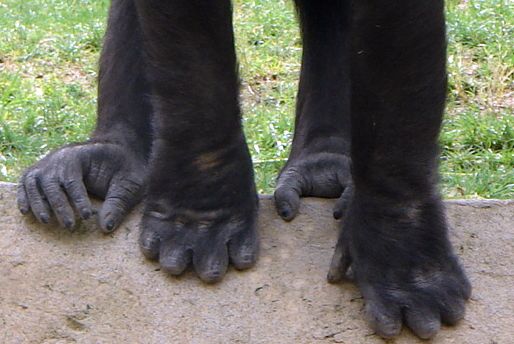Content created: 2010-09-09
File last modified:
Glossary
Close this window.
- Australopithecus
- One of the genera of hominid (q.v.).
- cc
- Cubic centimeters (a measure of volume), identical with milliliters (ml), a measure of capacity, usually used for liquids. See “cranial capacity.”
- cranial capacity
- The amount of space within a skull that is occupied by the brain, used in fossil work as an indicator of brain size and an indirect indicator of approximate intelligence. Measured in ml or cc. (For comparison, most modern chimpanzees have cranial capacity in the range of 300-400 cc. Modern humans average about 1350 cc.)
- dimorphic
- Adjective form of “dimorphism.”
- dimorphism
- The condition in which the same species routinely exhibits are two different forms for some characteristic(s). The most important use of the term is for sexual dimorphism,, wherein males and females vary consistently and significantly in average, height, weight, shape of canine teeth, or other features. (In addition to sexual dimorphism within a species, there can be a substantial same-sex size differences, but typically over a continuous range. A species may also contain a number of varieties, but again over a continuous range.) (From di-morph = “two forms.”)
- Click for More About Sexual Dimorphism.
Close this window.
- foramen magnum
- The hole in the bottom of a skull through which the spinal chord connects the brain with the rest of the body. In bipedal hominids, the foramen magnum is at the bottom of the skull, since the skull tops a vertical spine. In arboreal and and knuckle-walking primates, the foramen magnum is usually slightly further back. In quadrupedal animals, such as dogs, the foramen magnum is towards the back of the skull, since it accommodates a horizontal spinal column.
- gracile
- Small-boned (as opposed to robust in a species with non-sexual dimorphism).
- hominids (hominidae)
- A grouping that includes humans and human ancestors since the split from our last ape ancestor (approximately 5-8 million years ago), as well as closely similar collateral branches, most importantly, the genus Australopithecus.
- hominoids (hominoidea)
- A grouping that includes include hominids and also include modern apes and their (and our) ancestors since the split from our last monkey ancestor (approximately 30 million years ago). (Mnemonic: HominOID is a longer word and a larger category. HominID is a shorter word and a smaller category.)
- Homo
- One of at least two genera of hominid. The other is Australopithecus. Many scholars argue that Ardipithecus is a third. Others are likely.
- honing
- Sharpening. The word is used to refer to the abrasion of long canine teeth as they brush against the premolars of the opposite jaw. (Earlier forms had four premolars, although the hominid line preserves only the rear two of these, which paleontologists therefore refer to as the third and fourth rather than the first and second. Honing is sometimes called C/P3 honing, in other words, abrasion of the canine against the "third" premolar, the front-most one seen in hominids.)
- Click for More About Teeth and Dentition.
Close this window.
- KNM
- Kenya National Museums. (Hence: KNM-WT = Kenya National Museums-West Turkana site, KNM-OH = Kenya National Museums-Olduvai Hominid.)
- knuckle walking (KW)
 Locomotion by resting the weight of the body on the soles of the back feet and the knuckles of the hands/forefeet. Among knuckle walkers the upper part of each finger bends "backwards" slightly, so that the weight-bearing knuckle is centered directly under the arm. The picture here shows the right hand of a modern gorilla in such a position.
Locomotion by resting the weight of the body on the soles of the back feet and the knuckles of the hands/forefeet. Among knuckle walkers the upper part of each finger bends "backwards" slightly, so that the weight-bearing knuckle is centered directly under the arm. The picture here shows the right hand of a modern gorilla in such a position.
- kya
- Thousand years ago (same as tya).
- ml
- Milliliters, a measure of capacity (usually used for liquids). See "cc."
- morphological groups
- Groups based on form and structure.
- mya
- Million years ago.
Close this window.
- Paranthropus
- A genus name assigned to certain robust forms formerly included with Australopithecus, most importantly P. boisei and P robustus.
- postcranial
- Refers to skeletal characteristics from the neck down, i.e., all of the skeleton except the head.
- robust
- Large-boned (as opposed to gracile in a species with non-sexual dimorphism).
- sagittal crest
- A bony ridge along the top of the skull, running from front to back. Its function is to provide a larger attachment area for especially large (strong) chewing muscles in animals (such as gorillas) where the surface of the skull proper does is not large enough for such large muscles.
- tya
- Thousand years ago (same as kya).
Close this window.
 Locomotion by resting the weight of the body on the soles of the back feet and the knuckles of the hands/forefeet. Among knuckle walkers the upper part of each finger bends "backwards" slightly, so that the weight-bearing knuckle is centered directly under the arm. The picture here shows the right hand of a modern gorilla in such a position.
Locomotion by resting the weight of the body on the soles of the back feet and the knuckles of the hands/forefeet. Among knuckle walkers the upper part of each finger bends "backwards" slightly, so that the weight-bearing knuckle is centered directly under the arm. The picture here shows the right hand of a modern gorilla in such a position.